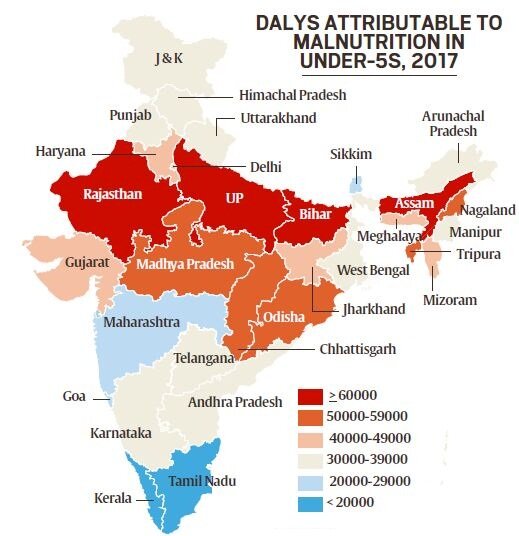Social Justice
Malnutrition and Disease Burden
- 19 Sep 2019
- 6 min read
A study led by the Indian Council of Medical Research (ICMR), has given comprehensive estimates of disease burden due to child and maternal malnutrition and the trends of its indicators in every state of India from 1990 to 2017.
- The estimates were produced as part of the Global Burden of Diseases Study (GBD) 2017.
- The Global Burden of Disease Study is a comprehensive regional and global assessment of mortality and disability from major diseases, injuries, and risk factors.
- The study was initiated in the 1990s as a collaborative effort of hundreds of experts worldwide, including researchers at the World Health Organization (WHO), and the World Bank.
Key Findings
- Child and maternal malnutrition is still a leading cause of:
- Death Rate: Although, the death rate attributable to malnutrition in under-5 children, has dropped by two-thirds from 1990 to 2017. Malnutrition is, however, still the underlying risk factor for 68% of the deaths, ranging between a high of 72.7% in Bihar and a low of 50.8% in Kerala.
- Disability-Adjusted Life Years (DALY): DALY rate attributable to malnutrition in children varies 7-fold among the states — a gap between a high of 74,782 in Uttar Pradesh and a low of 11,002 in Kerala.
- Anaemia: The prevalence of anaemia in women was at 54% in 2017.
- Low Birthweight: It is the largest contributor to child deaths among all malnutrition indications, followed by child growth failure which includes stunting, underweight, and wasting. Also, its rate of decline is among the lowest.
- Overweight: It is becoming a significant public health problem as it is increasing rapidly across all States.
- Implication: The country may miss global targets with respect to malnutrition and others for the year 2030, set by the World Health Organization (WHO) and the United Nations Children's Fund (UNICEF) and those included in the Sustainable Development Goals (SDGs).
- Suggestions:
- Improving the overall nutritional status of girls and women during the preconception and pregnancy period and providing quality antenatal care can positively influence low birth weight indicators.
- Focus is needed on major determinants like provision of clean drinking water, reducing rates of open defecation, improving women’s educational status, and food and nutrition security for the most vulnerable families.
- It is important to plan the reduction in malnutrition in a manner that is suitable for the trends and context of each State.
Note
Disability-Adjusted Life Years (DALYs) is the sum of the number of years of life lost due to premature death and a weighted measure of the years lived with disability due to a disease or injury. The use of DALYs to track disease burden is recommended by India’s National Health Policy of 2017.
Anaemia
- It is a condition in which the number of red blood cells or their oxygen-carrying capacity is insufficient to meet physiologic needs, which vary by age, sex, altitude, smoking, and pregnancy status.
- Iron deficiency is the most common cause of anaemia, although other conditions, such as folate, vitamin B12 and vitamin A deficiencies, chronic inflammation, parasitic infections, and inherited disorders can all cause anaemia.
- In its severe form, it is associated with fatigue, weakness, dizziness and drowsiness. Pregnant women and children are particularly vulnerable.
Malnutrition
- Malnutrition refers to deficiencies, excesses or imbalances in a person’s intake of energy and/or nutrients.
- The term malnutrition covers two broad groups of conditions.
- One is ‘undernutrition’—which includes stunting (low height for age), wasting (low weight for height), underweight (low weight for age) and micronutrient deficiencies or insufficiencies (a lack of important vitamins and minerals).
- The other is overweight, obesity and diet-related noncommunicable diseases (such as heart disease, stroke, diabetes and cancer).
Steps Taken by India
- Mid-day Meal (MDM) scheme aims to improve nutritional levels among school children which also has a direct and positive impact on enrolment, retention and attendance in schools.
- Under the Pradhan Mantri Matru Vandana Yojana (PMMVY), Rs.6,000 is transferred directly to the bank accounts of pregnant women for availing better facilities for their delivery.
- POSHAN Abhiyaan, launched in 2017-18, aims to reduce stunting, under-nutrition, anaemia and low birth weight babies through synergy and convergence among different programmes, better monitoring and improved community mobilisation.
- The National Food Security Act (NFSA), 2013, aims to ensure food and nutrition security for the most vulnerable through its associated schemes and programmes, making access to food a legal right.







